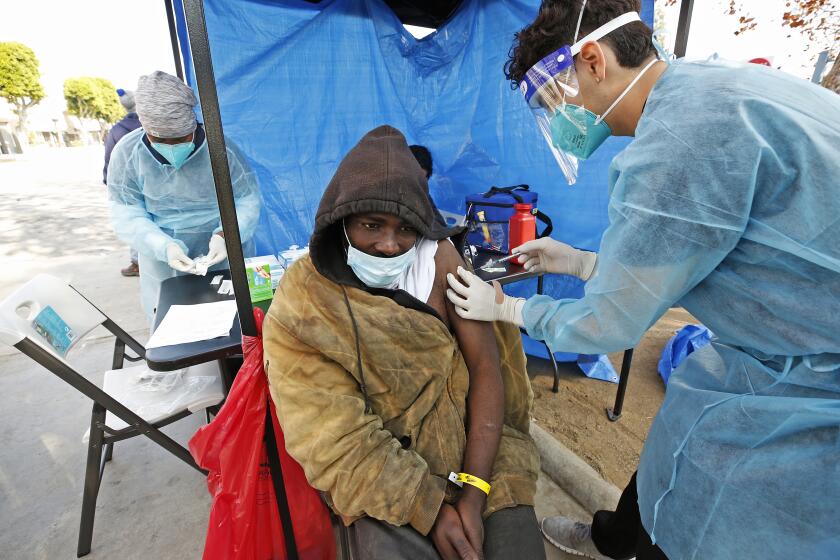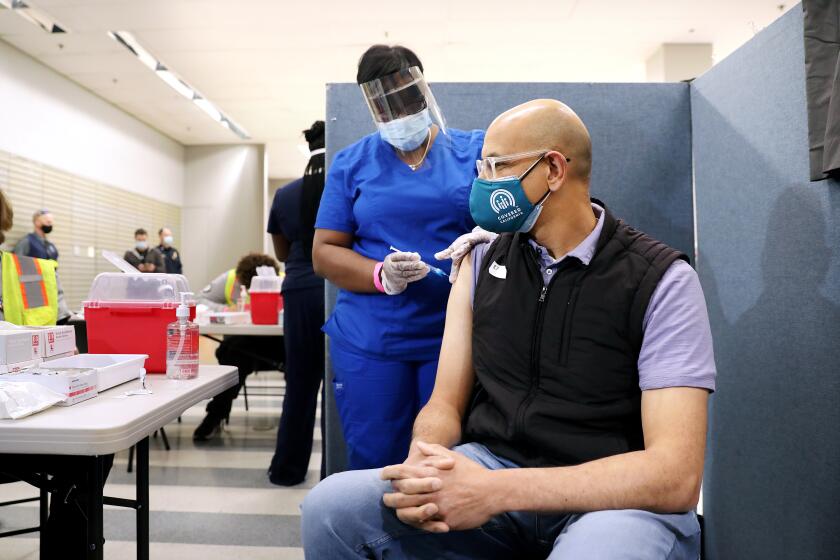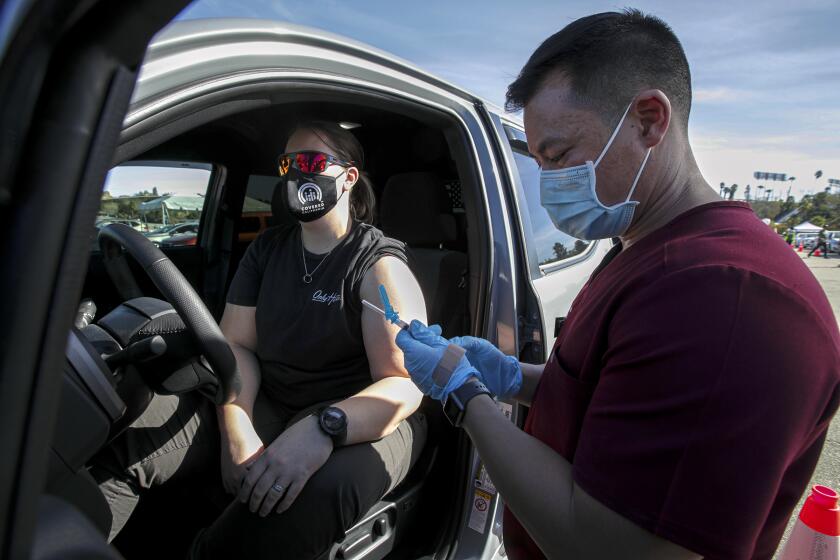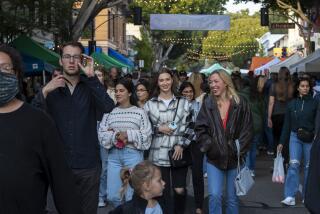California hits target of 2 million vaccines in low-income areas, clearing way for wider reopenings
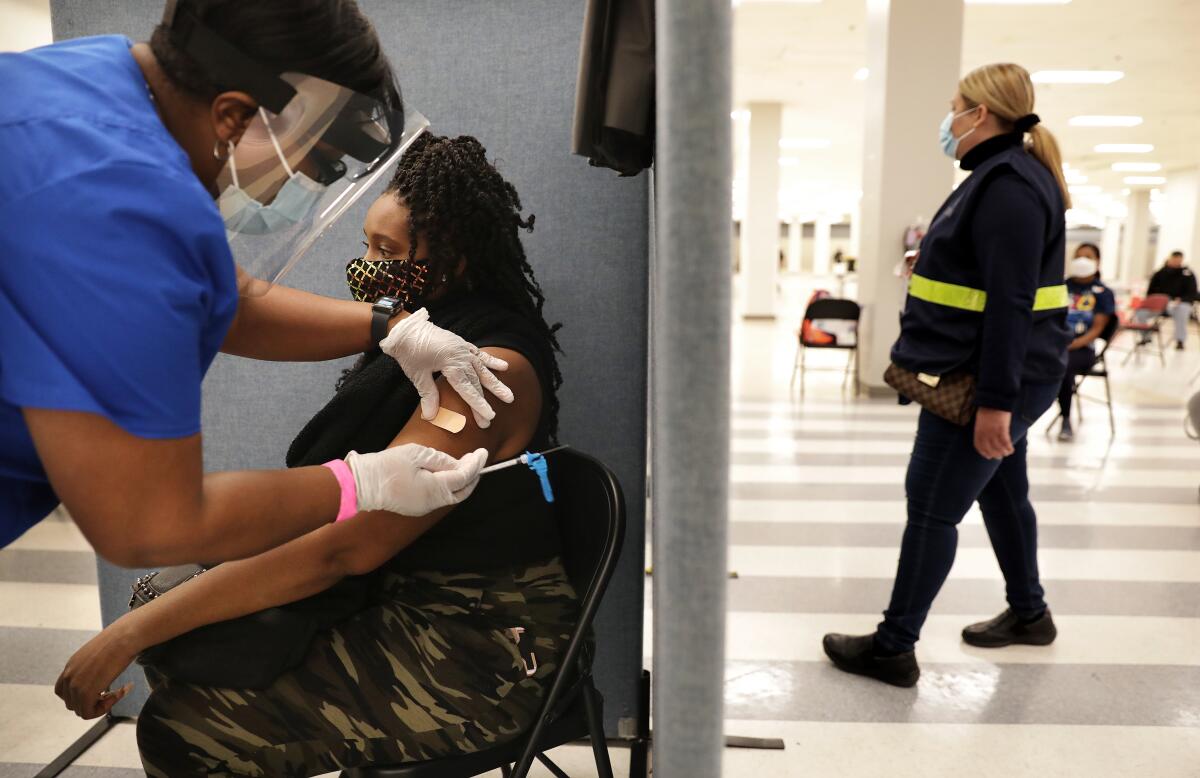
- Share via
California has met its initial target for administering more COVID-19 vaccines in the hardest-hit and most disadvantaged areas, signifying the state’s effort to more equitably distribute the doses and clearing the way for significant economic reopenings.
With 2 million doses now having gone into the arms of residents in targeted communities statewide, officials have loosened the criteria for counties to exit the strictest of California’s four-tier reopening plan.
The move sets the stage for a wider unlocking of the state’s battered economy. Thirteen counties — Los Angeles, Orange, San Bernardino, Amador, Colusa, Contra Costa, Mendocino, Mono, Placer, San Benito, Siskiyou, Sonoma and Tuolumne — will exit the proscriptive purple tier Sunday, according to the California Department of Public Health.
Another 13 counties — Sacramento, San Diego, Riverside, Ventura, Kings, Lake, Monterey, San Joaquin, Santa Barbara, Sutter, Tehama, Tulare and Yuba — are poised to also join the red tier as soon as Wednesday, provided their coronavirus metrics stay steady.
“California is making good strides on achieving the commitment to delivering doses to the hardest-hit communities across our state, making sure that our first line of protection is going to those places that have shouldered the greatest burden of disease,” Dr. Mark Ghaly, California’s health and human services secretary, said during a briefing Friday.
Counties in the red tier will be permitted to resume indoor dining at restaurants and movie theater showings at 25% capacity, welcome back students in person in grades 7 through 12, reopen indoor gyms and dance and yoga studios at 10% capacity, and expand capacity restrictions at nonessential stores and libraries.
Museums, zoos and aquariums also can reopen indoor operations, at 25% capacity.
L.A. County will allow theaters, restaurants, gyms and more to more widely reopen Monday. The changes come as COVID-19 cases continue to plummet.
Amusement parks can reopen at 15% capacity, with other modifications, starting April 1. Long-closed attractions such as Disneyland, Universal Studios, Knott’s Berry Farm and Six Flags Magic Mountain are weeks away from again welcoming visitors — who must be California residents — after being closed for a year.
Opening more venues is not cause for Californians to let their guard down, Ghaly emphasized. He said there is still reason to be cautious about participating in newly allowed activities, such as dining indoors at restaurants, as any venue where people aren’t wearing masks the entire time carries a risk for infection.
Mixing with people from another household, for instance, should still be done carefully, and it remains safer to dine outdoors than inside in a mixed-group setting, he said.
“We continue to believe that the [California] blueprint has some of the strongest public health protections in the nation,” Ghaly said, adding that, should counties begin to see their numbers worsen, “we will, of course, continue to have the protection of the purple tier.”
L.A. County is making the homeless population eligible for vaccination.
How widely to reopen ultimately is up to local health officials, who can adopt rules that are stricter than the state.
While some counties have clamored throughout the pandemic for wider latitude to reopen their economies, others have adopted a slower approach.
The timing is also somewhat county-dependent. L.A. County health officials — along with their counterparts in the cities of Long Beach and Pasadena, which have independent public health departments — said red-level reopenings will take effect at 12:01 a.m. Monday. Orange and San Bernardino counties, on the other hand, said they planned to move ahead Sunday.
L.A. County Health Officer Dr. Muntu Davis said the decision to wait until Monday “is really to give businesses some time” to prepare and appropriately modify their operations as necessary.
“We want them to understand what the requirements are, have some time to put those things in place,” he said during a briefing Friday.
Whatever the timing, officials said moving from the purple tier to the red is a sign of the hard-won progress counties have made to beat back the fall-and-winter coronavirus surge, and a testament to the power residents and businesses have to combat the pandemic.
“People throughout our county have worked relentlessly over the past year to protect each other’s health and safety,” San Bernardino County Supervisor Curt Hagman said in a statement. “This has been a community-wide effort involving everyone from healthcare professionals and essential workers to businesses and residents following strict public health protocols. Our diligence is now beginning to pay off.”
L.A. County Supervisor Hilda Solis called the forthcoming move “welcome news” but cautioned “that in no way means we can drop our guard now,” she said in a statement. “We owe it to our neighbors, our local businesses and our children to remain vigilant so that the reopenings are safe and long-lasting. Wearing masks and physical distancing remain critical.”
In an interview Friday, Orange County Supervisor Lisa Bartlett said, “It feels like we’re finally turning the corner and people are starting to see the light at the end of the tunnel.”
California is expected to have vaccinated 2 million residents of it most disadvantaged areas by Friday, allowing more counties to exit the purple tier.
The accelerated advancement in L.A. and elsewhere is made possible through a revision to California’s reopening road map unveiled last week.
In a bid to address inequities in its vaccine rollout, the state is now earmarking 40% of available supplies for residents in the most disadvantaged areas, as identified by a socioeconomic measurement tool called the California Healthy Places Index.
Specifically, those doses would go to communities in the lowest quartile of the index — which includes roughly 400 ZIP Codes throughout the state in places such as South Los Angeles, the Eastside, Koreatown, Chinatown, Compton, southeast L.A. County, the eastern San Fernando Valley, Santa Ana and a number of heavily Latino communities along the 10 Freeway corridor between Pomona and San Bernardino.
As part of the new targeted strategy, the state set goals of administering the first 2 million doses in those areas, then 4 million. After reaching each mark, California aims to redraft its reopening road map to make it easier for counties to more widely resume economic operations.
Five of the state’s top doctors get the Johnson & Johnson vaccine in front of news cameras as officials seek to promote the most recently approved shot.
The state system categorizes counties into one of four color-coded tiers based on a few factors: testing positivity rates; a health equity metric intended to ensure that the positivity rate in poorer communities is not significantly worse than the county’s overall figure; and, crucially in terms of wider reopenings, case rates.
Originally, counties had to record a rate — adjusted based on the number of tests performed — at or below 7.0 new coronavirus cases per day per 100,000 people to move from the purple to the red tier.
With the state having met its 2-million-dose goal, counties with a case rate of up to 10.0 new cases per day per 100,000 people are now eligible to advance. Counties still need to log two consecutive weeks of sufficiently low case rates to move forward.
Not only will that shift make it easier for counties to progress, but it will also give them additional breathing room to dodge a potential regression back into the purple tier.
“Orange County had been hovering at the 7 mark for an extended period of time, and we couldn’t really break through that,” Bartlett said. “Now we have a buffer, so even if we were to see a slight increase in cases, we would still remain in the red tier.”
When asked whether there’s concern that California could still be hit by another coronavirus wave — particularly one fueled by more contagious variants — Ghaly said that he couldn’t rule it out but that he’s hopeful vaccinations will continue at a healthy clip, better armoring the state against that possibility.
“That said, we expect that there will be ups and downs with case rates,” he said.
The Los Angeles County Department of Public Health says hundreds of thousands of additional people will become eligible for shots beginning next week.
When the state reaches its next goal of administering 4 million doses in the hardest-hit areas, the threshold to move into the orange tier would be relaxed from a requirement of under 4.0 new cases per day per 100,0000 residents to under 6.0. Entering the least restrictive tier, yellow, would necessitate an adjusted daily new case rate below 2.0 per 100,000 people, compared with the current requirement of less than 1.0.
But, as Ghaly acknowledged, “we have quite a bit of work ahead to get from 2 million doses to 4 million.”
Gov. Gavin Newsom said this week that the state is also working on a new green tier “in anticipation of this bright light now at the end of this tunnel,” though he didn’t specify what that would look like.
“As we start to reopen, as we get to 10, 15, 20 million vaccinations, get closer and closer [to] herd immunity, then we will start to make it clear that these tiers were temporary,” he said. “They’re not permanent, and there’s something beyond orange and yellow.”
Over the last week, providers throughout California have administered an average of almost 188,000 COVID-19 vaccine doses per day, according to data compiled by The Times. More than 11.1 million doses have been doled out statewide.
California releases details on how millions can get COVID-19 vaccinations beginning Monday
Californians who are 65 and older, or work in the specified fields of food and agriculture, education and child care, or healthcare and emergency services, are eligible to be vaccinated.
Starting Monday, an estimated 4.4 million California residents with certain disabilities or underlying health conditions will be able to join the line, too, as will Los Angeles County’s entire homeless population.
Officials say they expect that the supply of available doses will remain crunched over the next few weeks, though they’re hopeful supplies will be more robust in the spring.
“Our job in the state is getting ready for whatever the federal government or manufacturers can send us, and that’s what we are working hard to be ready for,” Ghaly said.
That optimism was boosted when President Biden announced that restrictions on who can make a COVID-19 vaccine appointment will be lifted nationwide by May 1.
A major priority before then will be to continue getting doses into the arms of the Californians living in the hardest-hit regions, Ghaly said. People living in the state’s poorest areas have died of COVID-19 at a disproportionately high rate, yet they have received half as many vaccine doses as people living in the wealthiest areas of California.
Amid optimism over the vaccine rollout, health officials continue to urge caution, saying California can ill afford to let its guard down and risk another resurgence of a disease that has already killed more than 55,000 people statewide.
Taking steps to stymie transmission of the virus — including wearing masks in public, regularly washing hands and avoiding crowds, particularly indoors — remain vital, officials and experts say.
The state’s metrics are heading in a promising direction. Over the last week, California has reported an average of 3,881 new coronavirus cases per day, a roughly 33% decrease from two weeks ago, The Times’ data show.
Hospitalizations also have fallen dramatically from the peak of the fall-and-winter surge and returned to levels not seen since mid-November. On Thursday, 3,335 COVID-19 patients were hospitalized statewide, with 966 in intensive care.
“This disease continues to be deadly. This disease continues to be ubiquitous,” Newsom said. “It is not taking spring break off. This disease is not going to take the summer off.
“It will only be extinguished by each and every one of us doing what we must to mitigate the spread,” the governor added. “That’s why it’s so important we don’t run the 90-yard dash.”
Times staff writer Hannah Fry contributed to this report.
More to Read
Sign up for Essential California
The most important California stories and recommendations in your inbox every morning.
You may occasionally receive promotional content from the Los Angeles Times.

